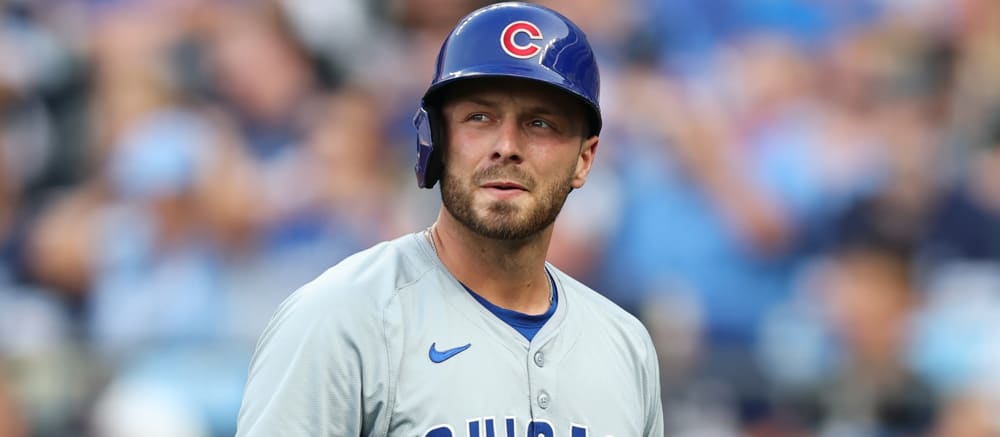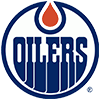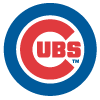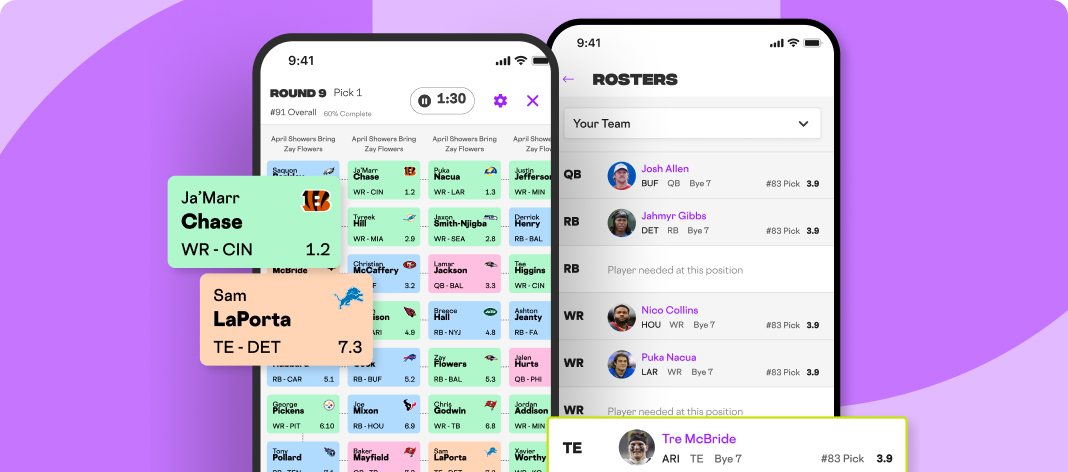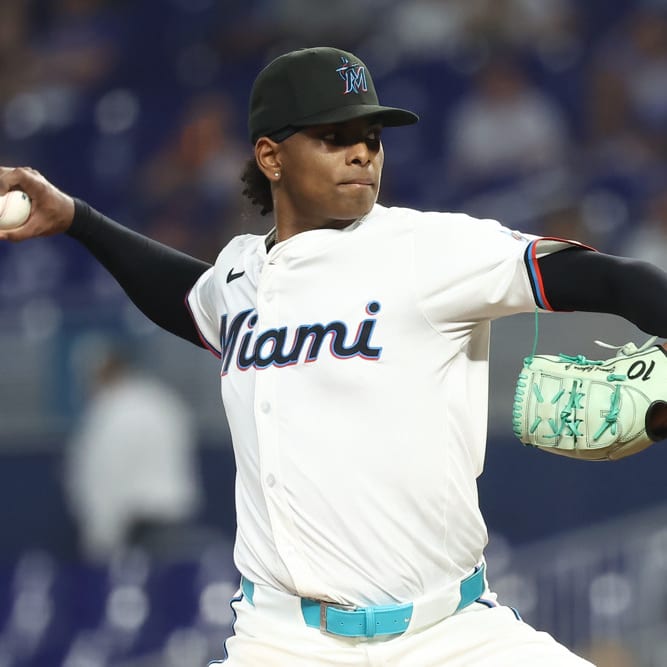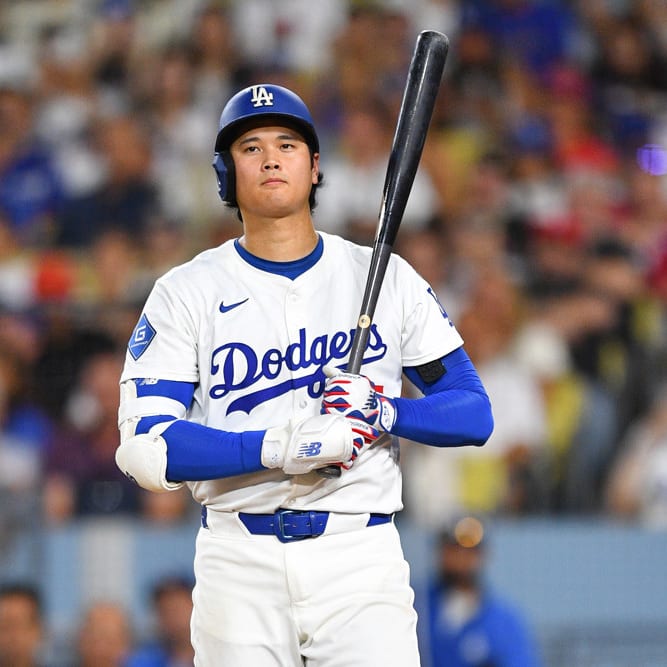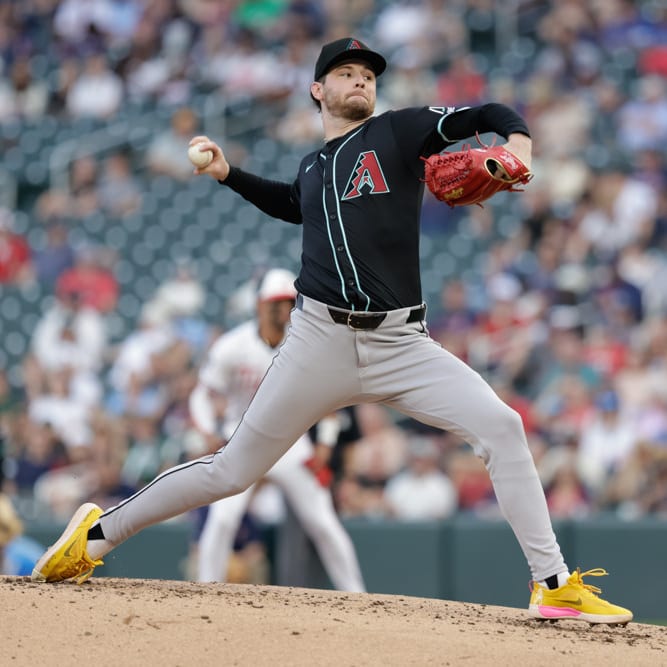Every few years I detail what goes into the Pitching and Hitting Rankings. We're due for a refresh. But first, here are the previous iterations, for those curious about the evolution of the rankings.
- Meet the New Individual Weekly Player Rankings April 3, 2024
- Weekly Rankings Primer April 13, 2022
- Weekly Rankings Primer April 2, 2021
- Weekly Rankings Primer March 30, 2018
- Revamping the Weekly Hitting Rankings June 29, 2017
- Showing Your Work April 20, 2017
Pitching Rankings
Projection Methodology
The process is almost 100 percent formulaic. The rankings begin with a rest-of-season projection for each pitcher. These are generated by adjusting my initial projection with in-season performance. The changes are based on skills, using a weighted average of in-season and expected. Some skills become "real" sooner, which is captured my the model. I will occasionally override my initial expectation if I feel the algorithm isn't catching up to the current level. That said, I usually need a reason (increased velocity, new pitch, different sequencing, etc.).
The rest-of-season projection is distilled to per inning and adjusted for the venue and opposition.
Opponent adjustments are done via normalization. Every offense is compared to the league average and assigned a normalization coefficient. This is done by skill, with a team mark of "1" meaning the team is league average. Anything below one is worse than average while above one indicates better than average. Coefficients for strikeouts, hits, homers and walks are determined and then used to adjust the pitcher's projection. These coefficients
Every few years I detail what goes into the Pitching and Hitting Rankings. We're due for a refresh. But first, here are the previous iterations, for those curious about the evolution of the rankings.
- Meet the New Individual Weekly Player Rankings April 3, 2024
- Weekly Rankings Primer April 13, 2022
- Weekly Rankings Primer April 2, 2021
- Weekly Rankings Primer March 30, 2018
- Revamping the Weekly Hitting Rankings June 29, 2017
- Showing Your Work April 20, 2017
Pitching Rankings
Projection Methodology
The process is almost 100 percent formulaic. The rankings begin with a rest-of-season projection for each pitcher. These are generated by adjusting my initial projection with in-season performance. The changes are based on skills, using a weighted average of in-season and expected. Some skills become "real" sooner, which is captured my the model. I will occasionally override my initial expectation if I feel the algorithm isn't catching up to the current level. That said, I usually need a reason (increased velocity, new pitch, different sequencing, etc.).
The rest-of-season projection is distilled to per inning and adjusted for the venue and opposition.
Opponent adjustments are done via normalization. Every offense is compared to the league average and assigned a normalization coefficient. This is done by skill, with a team mark of "1" meaning the team is league average. Anything below one is worse than average while above one indicates better than average. Coefficients for strikeouts, hits, homers and walks are determined and then used to adjust the pitcher's projection. These coefficients consider the handedness of the pitcher.
The adjusted skills are used to calculate the projected ERA and WHIP for the outing.
The next step is projecting the length of each start. This is subjective but based on history, recent outings and quality of opponent.
At this point, almost everything needed is available. The only missing element is a wins projection. This is determined using the Bill James Pythagorean Theorem. The inputs are runs scored and runs allowed but all we have are the contributions from the starting pitchers. As such, the runs allowed by each team's bullpen is computed and added to that of the starting pitchers. If a starter is projected for 5 1/3 innings, the bullpen is assumed to handle the other 3 2/3. It's not perfect, since different relievers are deployed when winning and losing, but it works for this purpose.
The likelihood of victory for each team is determined. The chance of a starter earning a win depends on how deep into the game they lasted. Historical data is used to convert the team win chance to that of the pitcher. We now have everything needed to rank each starter (IP, W, K, HR, H and BB)
Rankings Methodology
The projected stats for the week are determined, adding together the numbers from those with two starts. These are now ranked rotisserie style.
The counting stats are straightforward: the pitcher with the highest W and K projections collect the most points and the rest are scaled down from there.
The ratio rankings are determined by how much each starters' projection affects league average ERA and WHIP over the average number of innings each fantasy team accrues per week.
The four category rankings are summed, with the highest total topping the rankings.
Including a dominant middle reliever is unique to these rankings. This is a non-closer, often deployed when there aren't enough favorable starting pitchers available. The relievers' projections are derived from the typical dominant setup men in each format. They offer some perspective when deciding to use a fringy starter. Pitchers above are better than the reliever while those below are less useful. Contest matters since low rankings are driven by low counting stats (usually for one-start guys) or high ratios (usually double-dippers). Team needs often dictate deployment of the fringe options.
The reliever rankings pass the sniff test. On average, the MIX 12 rank is in the low 80s. Assume every fantasy team starts two closers, leaving 84 starting pitchers. This leaves just three or four teams considering using a dominant middle reliever. From a practical sense, most relievers of this nature in a 12-team mixed league also have a chance to capture a save, since some will be closers.
The average dominant setup man in MIX 15 formats lands in the low 90s. Using similar math, 105 starters are needed, so almost every manager in 15-team league must at least consider utilizing a third reliever.
In 12-team AL and NL only formats, the algebra is a bit more complicated. Six-man rotations aside, there are only 75 starters available. Let's call it 78 to reflect six-man rotations. This isn't sufficient for each team to use seven starters (84 needed). Not to mention, many of these starters are not fantasy assets.
Let's be generous and suggest the top three starters on each MLB team are usable, then add in 15 closers. We're at 60 pitchers. meaning 48 more are needed to fill each activate rotation. Some will be the better fours and fives on a major league staff; the rest are relievers, some of which have a reasonable chance at a save on MLB teams without a frontline closer.
The dominant reliever averages mid to high 50s. With 45 starters already accounted for, most teams will use a sixth starting pitcher, but a few may opt to deploy five starters and four relievers. This is consistent with reality.
Miscellaneous
The final nuance with the pitching rankings is the inclusion of roster percentages in the 12-team NFBC RotoWire Online Championship and 15-team NFBC Main Event. These were added by popular demand a few years ago. Any starter with a roster rate of less then 50 percent is noted on the initial Saturday posting. Since the Sunday night update is posted after the NFBC FAAB run, they're not included.
As is noted every week on the report, the schedule is pulled from the Probable Pitchers grid. On very rare occasions, I'll override the grid. Any questions pertaining to the schedule are best directed to those birddogging the probable pitcher news. They can best address the reason(s) for the rotations. Often, there will be changes reported after the initial posting occurs on Saturday. As such, a final update is posted late Sunday night, early Sunday morning.
I try to provide comments as needed, often lighthearted. While I consider them an important aspect of the rankings, I prefer to spend as much time as possible updating and maintaining all the pertinent info that generates the rankings. There are times this limits the number of comments while still posting in a timely manner.
Team Hitting Rankings
Most of the team rankings evolved from reader request.
HR LHB and HR RHB
Weighted average of the park factors each handedness of hitters is slated to play in for the week,
SB
The ability to defend stolen bases is determined for each team. This entails using historical data of the scheduled pitchers and the team's catchers then adjusting to in season performance. The scores are normalized with 100 reflecting the league average. The number presented for each team is the weighted average of scheduled opponents. Anything over 100 indicates the team is facing opposition throwing out runners at a below average pace. If you're deciding between a couple of fringe batters, and you need steals, this column provided useful information.
P LHB and P RHB
The wOBA allowed for the opposing pitchers is the measuring stick for this column. It was decided to use wOBA as opposed to batting average against since wOBA is a good approximation for overall production, but it makes sense to use this as a proxy for batting average. If a team faces pitchers yielding a high wOBA, chances are they are allowing a high batting average against. Each pitcher's wOBA vs. LHB and wOBA vs. RHB is determined and normalized to a league average of 100. The numbers in the table are the weighted average of the opposing pitcher, adjusted to venue. Teams with a score over 100 should enjoy a productive week as they face below average pitching.
Runs
As detailed in the pitching section, the projected number of runs each team will score per game is calculated. These are summed and normalized to the league average of 100. Teams with a score over 100 are projected to score an above average number of runs for the period.
Ave LHB and Ave RHB
As I am typing this, it is apparent that I need to rename these columns as they may give the impression that they reflect the quality of opposition in terms of batting average against. As mentioned, that is best gleaned from P LHB and P RHB.
These columns average the other columns. In full disclosure, the early iterations of these rankings did not include these rankings. My thinking was decisions are made based on the specific categories, but readers insisted on an overall ranking, so we workshopped a weighted average of the other categories and incorporated the number of games played per week.
Total
The total is simply an average of Ave LHB and Ave RHB.
Individual Player Hitter Rankings
This is the second year for individual player rankings. They're based off NFBC Cutline scoring, which is designed to mimic 5x5 scoring. I was a consultant when the NFBC concocted the system, helping improve the correlation to over 90 percent.
Each player's numbers are projected for the games for that week. The site's projected lineups are used in conjunction with the probable pitchers grid. The projections are converted to Cutline points and summed for each period. To help choose between a pair of closely ranked players, the individual HR and SB points are included on the table.
The hitter's projections are determined similarly to that of the pitcher's. They start with a rest-of-season baseline, distilled to per plate appearance. They're then adjusted using park factor and quality of starting pitcher, bullpen and ability to defend stolen bases.
The number of plate appearances is captured from the spot in the batting order and average number of plate appearances each team generates from that spot.
The data is presented in a manner conducive to setting NFBC lineups. That is, 1H (first half) sums the points from Monday through Thursday while 2H (second half) totals the Friday through Sunday scores.
There is an admitted shortcoming of the methodology. Of course, the pitchers and lineups change over the course of the week, but these rankings consider the same information we all have at the time. The aspect I'd like to fine tune is accounting for teams using their bench more liberally than others. The default lineup assumes those players will play against all LHP or RHP. In reality, this isn't the case. On my end, automation is key. It's straightforward to download the default lineups and drop the information into the little black box. It's possible to archive each day's lineup to fine tune how often every player starts against RHP and LHP, and I am working on a means to facilitate the process. I hope to incorporate this improvement later in the season, but I make no promises.
As always, I'm happy to address questions and comments, keeping in mind that reader suggestions helped shape the rankings as currently presented.


